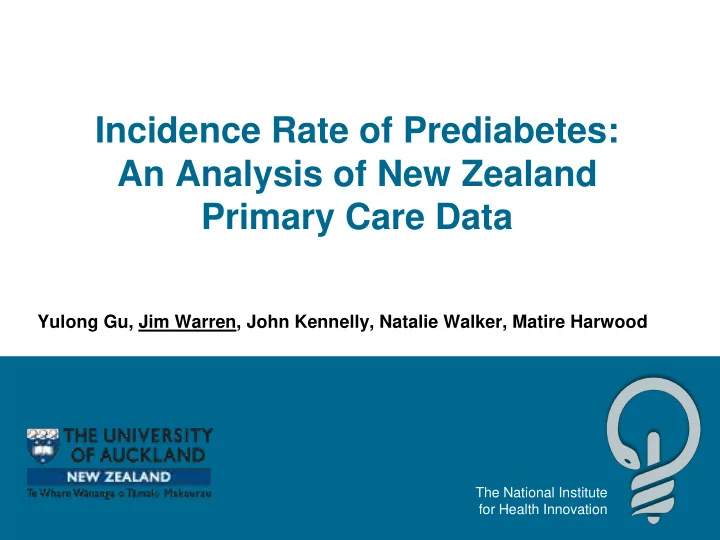

Incidence Rate of Prediabetes: An Analysis of New Zealand Primary Care Data Yulong Gu, Jim Warren, John Kennelly, Natalie Walker, Matire Harwood The National Institute for Health Innovation
Diabetes Mellitus (DM) epidemic • DM, affecting 9% of adult population worldwide, is a leading cause of premature death & disability. • NZ DM prevalence: 5.8%, with higher rates in Pacific (12.5%) and Māori Chen, L. et al. (2011) The worldwide epidemiology of type 2 (7.3%). diabetes mellitus — present and future perspectives Nat. Rev. Endocrinol. doi:10.1038/nrendo.2011.183
NZ guideline on DM management
What is already known about PreDM • People with impaired glucose tolerance (IGT or PreDM) are at high risk of Type 2 DM. • Lifestyle modification interventions are effective in preventing or delaying Type 2 DM development.
Study aim and design • To understand prediabetes incidence rate and HbA1c control status in the general adult population. • EMR data from 14 New Zealand general practices on enrolled patients (age≥20) were analysed to identify prediabetes by: – Having an initial HbA1c of 41-49 mmol/mol – Having had not been diagnosed (by READ or Rx) with DM by the first HbA1c of 41-49 time point.
Study sample • A total of 28,192 adults were included in the analysis • 14,963 women (53%). • Median age = 48, IQR: 37-61.
Findings – PreDM incidence rates Total # Patients who had Patients who had patients diabetes before prediabetes identified 2011 # (%) in 2011 # (%) Māori 3543 371 (10%) 140 (4%) Pacific 4052 685 (17%) 234 (6%) Non- Māori / 20597 1615 (8%) 902 (4%) non-Pacific Total: 28192 2671 (9%) 1276 (5%) • RR for preDM was increased for the Māori and Pacific groups versus non - Māori/ non -Pacific people, with RR of 1.96 in the younger age groups (<50 years) and RR of 1.33 in the 50+ group.
Findings – HbA1c control 41-49 50-54 55-64 65-79 80-99 ≥100 Year Patient # HbA1c Total ≤ 40 with uncontrolled HbA1c 2008 4404 33% 30% 9% 11% 9% 5% 3% 17% 2009 4310 35% 30% 10% 11% 9% 4% 3% 15% 2010 3798 29% 35% 10% 11% 8% 5% 2% 15% 2011 6194 31% 39% 9% 9% 7% 3% 3% 13% • RR for having uncontrolled HbA1c (highest HbA1c in 2011 ≥ 65 mmol/mol) increased for the Māori and Pacific groups versus non- Māori/non -Pacific people (RR = 3.35 among those <50 years, RR = 4.35 in the 50+ group).
Study implications • Given the high rates of DM & PreDM, opportunities exist for promoting public health interventions at the primary care setting in terms of – Identification and monitoring – More holistic risk assessment (e.g. CVR based on modified Framingham) – Followed by evidence-based management, e.g., Green Prescription (GRx)
Green Prescription (GRx) http://www.health.govt.nz/our-work/preventative-health-wellness/physical-activity/green- prescriptions/how-green-prescription-works
Study limitations • EMR data from primary care only, • The participating general practices had large case load of high-needs population, • We did not examine other physiological measures, other risk factors such as lifestyle or long-term outcomes. • Future EMR analysis could explore potential predictors and confounders, e.g., BMI or waist-to-hip ratio.
So what about BMI? PreDM DM noDM 100% • Yes, BMI is 90% 80% higher in 70% 60% ‘expected’ 50% 40% directions… 30% 20% 10% 0% HOWEVER 15 20 25 30 35 40 45 50 55 BMI Maori Pacific non-Maori / non-Pacific 100% 90% 80% 70% 60% 50% 40% 30% 20% 10% 0% 15 20 25 30 35 40 45 50 55 BMI
Recording of BMI is not universal 90 76.91 80 • More likely for 70 60 50.86 BMI to be 50 40 recorded with 26.51 30 20 diabetes 10 0 DM PreDM No DM – But even then not universal 50 47.01 45 – Recording is 40 33.87 35 probably biased 29.68 30 by other factors 25 20 15 10 5 0 Maori Other Pacific
Not a clean causal network • Factors will interact Lifestyle Diabetes Deprivation (e.g. diet) BMI Ethnicity • Most important message is the need to create preventative interventions that fit lifestyle and beliefs (as influenced by a range of socio- demographic factors) – Also a warrant for more studies with unbiased inclusion for measurement
Conclusion • EMR data identified an alarming incidence rate of prediabetes, especially among Māori and Pacific groups. • Given the already high prevalence of diabetes in Māori and Pacific groups, this highlights the need to better prevent and manage the disease progressing.
Acknowledgement • The data used in the analysis were collected in the Caring Does Matter (CDM) program funded by the Pacific Grant Fund, which is a fund of the New Zealand Ministry of Health. Further info: jim@cs.auckland.ac.nz
Recommend
More recommend